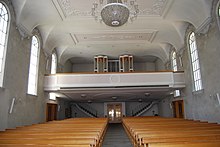St. Verena (Rickenbach)
The Sankt-Verena-Kirche in Rickenbach TG in the Münchwilen district is a Roman Catholic parish church that was built in its current form in 1845.
history
A St. Verena church was first mentioned in 838. Several village fires in 1445, 1636 and 1712 destroyed the parish church, only the bell tower withstood the fire. That is why the bottom stones of the tower come from the very first church. In 1655, Prince Abbot Gallus Alt gave the parish a baptismal font , which has been preserved to this day and is the oldest piece in the church. After the population of Rickenbach had increased, a new church building was inaugurated on August 6, 1845.
In May 1965 it was renovated, redesigned and extended by around 10 benches. During the renovation, the entire interior, the altar of the choir wall, the side altars and the pulpit were removed. The baptismal font and the oil paintings of Mary and Verena, venerated as a saint, on the side altars and on the ceiling remained. The stucco of the ceiling, the paintings of the side altars as well as the monstrance and a reliquary cross have been preserved.
Today the church has a modern choir wall and painted side altars. In the chancel there is now a simple, white altar table covered with gray sandstone. The work of art with the name Through the Cross and Death to the Resurrection on the choir wall was added in 1993.
architecture
The steeply visible steeple of the parish church of St. Verena dates from 1644. The nave itself was rebuilt in the mid-19th century in a classicist style.
organ
Today's organ
Today's neo-baroque organ , built in 1969 by Orgelbau Kuhn , with mechanical stop and action mechanisms, has the following disposition :
|
|
|
|||||||||||||||||||||||||||||||||||||||||||||||||||||
- Coupling : II / I, I / P, II / P
Since it is very humid in the church, the organ is strongly affected by mold. Sometimes it also has a valve hanger.
Previous instrument
The previous romantic pneumatic organ from 1907, which was also built by Kuhn (Karl Theodor Kuhn), contained the following registers :
|
|
|
|||||||||||||||||||||||||||||||||||||||||
First organ
The first organ, built in 1857, came from Remigius Haaser from Immenstadt im Allgäu and had six registers. It had a manual and an attached pedal. Your disposition is not known.
Bells
The bells were cast in 1965 by the Eschmann bell foundry located in the village . They ring in a 5-part C minor. The four previous bells, which stand on a pedestal in front of the church, were also cast by Emil Eschmann.
Web links
Individual evidence
- ↑ Catholic Church. Retrieved on March 29, 2020 (Swiss Standard German).
- ↑ a b Catholic parish Wil: Church of St. Verena. Retrieved March 29, 2020 .
- ^ Rickenbach near Wil - II / P / 21. From the website of the builder company, accessed April 17, 2020.
- ^ Rickenbach near Wil - II / P / 16. From the website of the builder company, accessed April 17, 2020.
- ↑ Catholic Church, Rickenbach TG, old organ. In: Organ Directory Switzerland-Liechtenstein , accessed on April 17, 2020.
- ↑ Catholic Church, Rickenbach TG, old organ. In: Organ Directory Switzerland-Liechtenstein , accessed on April 17, 2020.
Coordinates: 47 ° 26 '55.1 " N , 9 ° 3' 7.2" E ; CH1903: 721 673 / 256566

